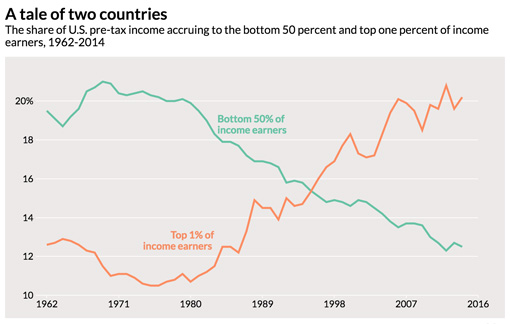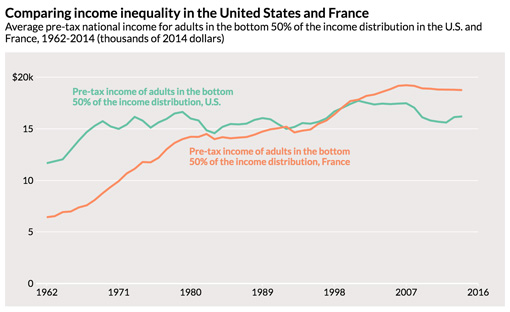Over at Equitable Growth, Thomas Piketty, Emmanuel Saez, and Gabriel Zucman provide a look at the latest numbers on income inequality in the United States:

The authors comment:
For the 117 million U.S. adults in the bottom half of the income distribution, growth has been non-existent for a generation while at the top of the ladder it has been extraordinarily strong….In the bottom half of the distribution, only the income of the elderly is rising….To understand how unequal the United States is today, consider the following fact. In 1980, adults in the top 1 percent earned on average 27 times more than bottom 50 percent of adults. Today they earn 81 times more.
Well, that’s the modern world for you, right? It’s all about skills and education and greater returns to rock stars. There’s really not much we can do about—oh wait. Here’s another chart:

Huh. Apparently you can run a thriving modern economy that benefits the working class as well as the rich. And note that this is pre-tax income. If social welfare benefits were included, the working class in France would be doing even better compared to the US:
The diverging trends in the distribution of pre-tax income across France and the United States—two advanced economies subject to the same forces of technological progress and globalization—show that working-class incomes are not bound to stagnate in Western countries. In the United States, the stagnation of bottom 50 percent of incomes and the upsurge in the top 1 percent coincided with drastically reduced progressive taxation, widespread deregulation of industries and services, particularly the financial services industry, weakened unions, and an eroding minimum wage.
We could do better for the working class and still maintain our economic dynamism if we wanted to. The only thing stopping us is that, apparently, we1 don’t want to.
1For a certain definition of “we,” that is.

















